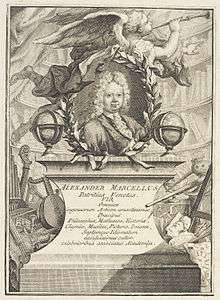Alessandro Marcello
Alessandro Ignazio Marcello (Italian: [marˈtʃɛllo]; 1 February 1673[1] – 19 June 1747[2] in Venice) was an Italian nobleman and composer.

Biography
Born in Venice, Marcello was the son of a senator. As such, he enjoyed a comfortable life that gave him the scope to pursue his interest in music. He was a contemporary of Tomaso Albinoni. He held concerts in his hometown and also composed and published several sets of concertos, including six concertos under the title of La Cetra (The Lyre), as well as cantatas, arias, canzonets, and violin sonatas. Marcello, being a slightly older contemporary of Antonio Vivaldi, often composed under the pseudonym Eterio Stinfalico, his name as a member of the celebrated Arcadian Academy (Pontificia Accademia degli Arcadi). He died in Padua in 1747.
Alessandro's brother was the more well-known Benedetto Marcello, also a composer, who illegally married his singing student Rosanna Scalfi in 1728. After his death she was unable to inherit his estate, and in 1742 she filed suit against Alessandro Marcello, seeking financial support.[3]
Works
Although most of his works are infrequently performed today, Marcello is regarded as a very competent composer. His La Cetra concertos are "unusual for their wind solo parts, concision and use of counterpoint within a broadly Vivaldian style," according to Grove, "placing them as a last outpost of the classic Venetian Baroque concerto."
The Concerto for Oboe and Strings in D minor op. 1 is perhaps his best-known work. Its worth was affirmed by Johann Sebastian Bach who transcribed it for harpsichord (BWV 974). A number of editions have been published, including an edition in C minor because the baroque oboe played a whole tone lower than the modern oboe.
Notes and references
- [MARCELLO, Alessandro Ignazio – Italian composer Benedetto Marcello's elder brother, was born in Venice on 1 February 1673, firstborn of Agostino, of the branch to the Magdalene, and of Paolina Cappello S. Lunardo, Venetian patricians. 24 August 1669, the date of birth of the composer reported in the family genealogies and accepted in the most recent encyclopedias, is actually that of a brother of the same name, who disappeared in childhood; it is the same Marcello, in a Latin epigram entitled De sua genitura, to confirm the data found in the baptismal faith. Treccani]
- Marcello's birth/death dates are given as 1684 to 1750 in The Grove Dictionary of Music and Musicians.
- Sadie, Julie Anne; Samuel, Rhian (1994). The Norton/Grove dictionary of women composers (digitized online by GoogleBooks). Retrieved 4 October 2010.
Sources
- The Grove Concise Dictionary of Music, Oxford University Press, 1994.